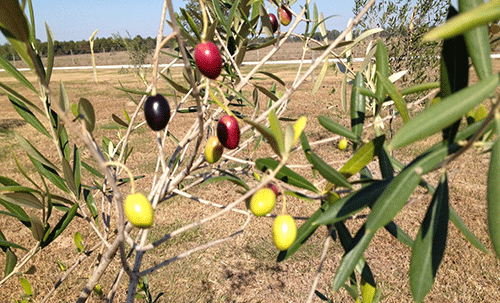Alabama olives
Baldwin County farmers plan commercial olive production

By Katie Jackson
If you love olives and olive oil, you no longer have to look to Spain, Italy or even California for some truly fine olive products. They can be found right here in the South, and possibly just outside your own door.
Olives are native to coastal areas of the Mediterranean and Middle East where abundant sunshine, temperate climates and well-drained soils offer ideal olive growing conditions. But the trees also do well in other parts of the world, including in the U.S. where olives are being grown on a commercial scale from California to, soon perhaps, Alabama.
Commercial olive production was first tried in Alabama in the early 1800s when a group of French expatriates established the ill-fated Vine and Olive Colony in west Alabama. That colony failed, in part because west Alabama’s growing environment was not suited for olives, and for many years afterward it was assumed that olives were not a viable crop for our state.
However, a renaissance in southern olive production is under way, led by the success of Georgia Olive Farms in Lakeland, Ga., which is producing high-quality, chef-endorsed olives and oils on a commercial scale. And now, thanks especially to the efforts of Baldwin County farmers Steve and Susan Quantz, Alabama may soon show its true olive potential.
The Quantzes stumbled onto the idea of growing olives when they visited a friend in Elberta who had two mature olive trees laden with fruit. “We were looking for an agricultural product that could make economic sense on small acreage,” says Steve, and seeing those two trees spurred the couple into researching the idea of growing olives on their own eight-acre farm.
That research led them to California’s olive-growing region where the Quantzes learned that their farm in Alabama had all the right ingredients for olive production. Soon thereafter they obtained and planted nearly 1,000 olive trees.
Though their orchard is less than a year old, the Quantzes hope to be producing enough olives within the next five years to begin processing them and also to open their operation to the public for tours, tastings and educational programs touting the health benefits and production potential of olives.

In fact, they are already hosting visitors, including a recent delegation of U.S. Department of Agriculture officials who Steve says had “lots of questions.” The Quantzes like lots of questions, though, because they want to see the Alabama olive industry grow. “We hope to demonstrate the viability of olives as a commercial crop for this region,” Steve says of their farm and their mission.
Interest in small-scale home-use olives is actually already strong, as Jason Powell with Petals from the Past nursery in Jemison can confirm. Petals began selling olive trees about four years ago in response to consumer demand and because they found a knowledgeable Texas supplier who had a great option for Alabama production—the Arbequina olive.
Arbequina, says Powell, is ideally suited to Alabama because it is cold hardy through zone 7, can handle the heat in the southern part of the state and is self-fruiting, so it does not require cross pollination from another olive variety to produce fruit. Customers are buying one or two to use in containers or in the landscape and some are even using them to establish small home orchards.
“These trees have attractive thin, blue-grey leaves and an airy open growth habit that allows you to train as a standard or multi-trunk tree,” Powell says. What’s more, they begin producing fruit within two years of planting, so they quickly become a great addition to a culinary garden.
Want to know more about olives in Alabama? Go to www.petalsfromthepast.com for information on an upcoming olive program at Petals from the Past or contact them at info@petalsfromthepast.com or 205-646-0069. To learn more about commercial production of olives in Alabama contact Steve Quantz at stevequantz@gmail.com.
September Tips
*Begin preparing the garden for winter by cleaning dead plants and debris from garden beds and the landscape.
*Take notes or draw a map of your beds and landscape, highlighting what worked and what failed in this year’s garden for use as you plan next year’s garden.
*Add lawn and garden debris to the compost, along with any organic (non-meat) kitchen waste.
*Test your soil so you’ll know what amendments to add this fall and winter.
*Plant fall and winter vegetables and root crops, such as cabbage, collards, celery, garlic and onions.
*Continue to mow and irrigate lawn as needed.
*Fertilize azaleas and camellias.
*Plant winter grass seeds on bare areas.
*Plant perennials and biennials and spring-flowering bulbs.
*Divide perennials and thin or transplant irises and daylilies.
*Clean bird feeders and birdbaths and keep them filled throughout the fall for resident and migratory birds.





